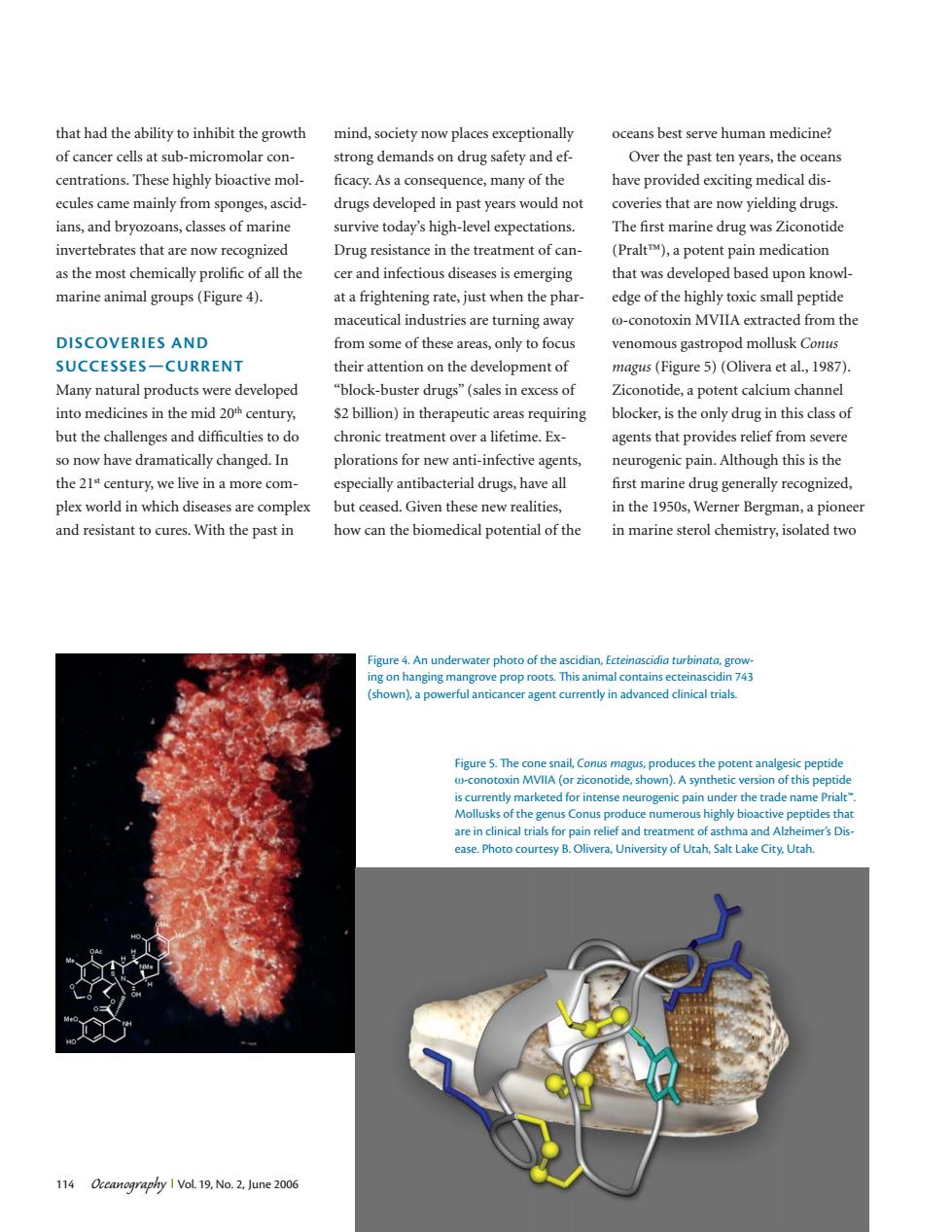正在加载图片...

that had the ability to inhibit the growth mind,society now places exceptionally oceans best serve human medicine? of cancer cells at sub-micromolar con strong demands on drug safety and ef- Over the past ten years,the oceans centrations.These highly bioactive mol- ficacy.As a consequence,many of the have provided exciting medical dis- ecules came mainly from sponges,ascid- drugs developed in past years would not coveries that are now yielding drugs ians,and bryozoans,classes of marine survive today's high-level expectations. The first marine drug wasZiconotid invertebrates that are now recognized Drug resistance in the treatment of can- (Pralt),a potent pain medication as the most chemically prolific of all the cer and infectious diseases isemerging that was developed based upon knowl- marine animal groups(Figure 4). at a frightening rate,just when the phar- edge of the highly toxic small peptide maccutical industries are turning away 0-conotoxin mVIlA extracted from the DISCOVERIES AND from some of these areas,only to focus venomous gastropod mollusk Conus successes-cuRrent their attention on the development of magus (Figure 5)(Olivera et al,1987). Many natural products were developed "block-buster drugs"(sales in excess of Ziconotide,a potent calcium channel into medicines in the mid 20 century. $2 billion)in therapeutic areas requiring blocker,is the only drug in this class of but the challenges and difficulties to do chronic treatment over a lifetime.Ex- agents that provides relief from severe so now have dramatically changed.In plorations for new anti-infective agents, neurogenic pain.Although this is the the 214 century,we live in a more com- especially antibacterial drugs,have all first marine drug generally recognized, plex world in which diseases are comple but ceased.Given these new realities, in the 1950s,Werner Bergman and resistant to cures.With the past in how can the biomedical potential of the in marine sterol chemistry,isolated two Figure4.An underwater photo of theascidian Ecteinasdi turbinata grow (shown)a powerful anticancer agent currently in advanced rials. is currenty marketed for intense pain under the trade are in ake City.Utah. 114 Oceaography I Vol 19,No..June 2006114 Oceanography Vol. 19, No. 2, June 2006 that had the ability to inhibit the growth of cancer cells at sub-micromolar concentrations. These highly bioactive molecules came mainly from sponges, ascidians, and bryozoans, classes of marine invertebrates that are now recognized as the most chemically prolifi c of all the marine animal groups (Figure 4). DISCOVERIES AND SUCCESSESCURRENT Many natural products were developed into medicines in the mid 20th century, but the challenges and diffi culties to do so now have dramatically changed. In the 21st century, we live in a more complex world in which diseases are complex and resistant to cures. With the past in mind, society now places exceptionally strong demands on drug safety and ef- fi cacy. As a consequence, many of the drugs developed in past years would not survive today’s high-level expectations. Drug resistance in the treatment of cancer and infectious diseases is emerging at a frightening rate, just when the pharmaceutical industries are turning away from some of these areas, only to focus their attention on the development of “block-buster drugs” (sales in excess of $2 billion) in therapeutic areas requiring chronic treatment over a lifetime. Explorations for new anti-infective agents, especially antibacterial drugs, have all but ceased. Given these new realities, how can the biomedical potential of the oceans best serve human medicine? Over the past ten years, the oceans have provided exciting medical discoveries that are now yielding drugs. The fi rst marine drug was Ziconotide (Pralt™), a potent pain medication that was developed based upon knowledge of the highly toxic small peptide ω-conotoxin MVIIA extracted from the venomous gastropod mollusk Conus magus (Figure 5) (Olivera et al., 1987). Ziconotide, a potent calcium channel blocker, is the only drug in this class of agents that provides relief from severe neurogenic pain. Although this is the fi rst marine drug generally recognized, in the 1950s, Werner Bergman, a pioneer in marine sterol chemistry, isolated two Figure 4. An underwater photo of the ascidian, Ecteinascidia turbinata, growing on hanging mangrove prop roots. Th is animal contains ecteinascidin 743 (shown), a powerful anticancer agent currently in advanced clinical trials. Figure 5. Th e cone snail, Conus magus, produces the potent analgesic peptide ω-conotoxin MVIIA (or ziconotide, shown). A synthetic version of this peptide is currently marketed for intense neurogenic pain under the trade name Prialt™. Mollusks of the genus Conus produce numerous highly bioactive peptides that are in clinical trials for pain relief and treatment of asthma and Alzheimer’s Disease. Photo courtesy B. Olivera, University of Utah, Salt Lake City, Utah